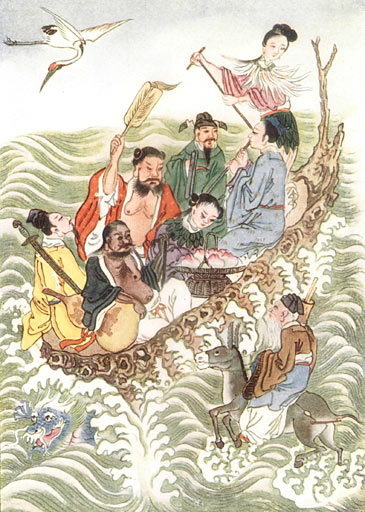|
Eight Immortals
The Eight Immortals () are a group of legendary ''Xian (Taoism), xian (immortals)'' in Chinese mythology. Each immortal's power can be transferred to a vessel () that can bestow life or destroy evil. Together, these eight vessels are called the "Covert Eight Immortals" (). Most of them are said to have been born in the Tang dynasty, Tang or Song dynasty, Song Dynasty. They are revered by the Taoism, Taoists and are also a popular element in secular Chinese culture. They are said to live on a group of five islands in the Bohai Sea, which includes Mount Penglai. The Immortals are: * He Xiangu (), in modern context generally seen as the only female of the group, often depicted holding a lotus flower. * Cao Guojiu (), related to a Song dynasty emperor before he became an immortal. * Li Tieguai (), considered to be mentally disturbed and associated with medicine and easing the suffering of the sick and needy, identified by his iron crutch and calabash bottle. * Lan Caihe (), originall ... [...More Info...] [...Related Items...] OR: [Wikipedia] [Google] [Baidu] |
Lake Heihai
Lake Heihai is a small salt lake, mesosaline lake in Golmud County, Haixi Prefecture, Qinghai Province, in western China. Names "Lake Heihai" is an English clarification of the pinyin romanization of Chinese, romanization of the Chinese language, Chinese name meaning . (As with Qinghai Lake, the Chinese word for "sea" is sometimes used to translate the Mongolian language, Mongolian ''naɣur'' (), which was once used ambiguously for all large bodies of water.) The lake is also known as ("Jade Pond of the Queen Mother of the West") from an old legendary location in the Kunlun Mountain (mythology), Kunlun Mountains and sometimes confused with Lake Hala in the Qilian Mountains. Geography Lake Heihai is located about south of the city of Golmud in Golmud County, Haixi Prefecture, Qinghai Province, at an elevation of or above sea level in western China. It lies in a valley roughly long and wide between the Kunlun Mountains (highest elevation about ) to the south and the Bu ... [...More Info...] [...Related Items...] OR: [Wikipedia] [Google] [Baidu] |
